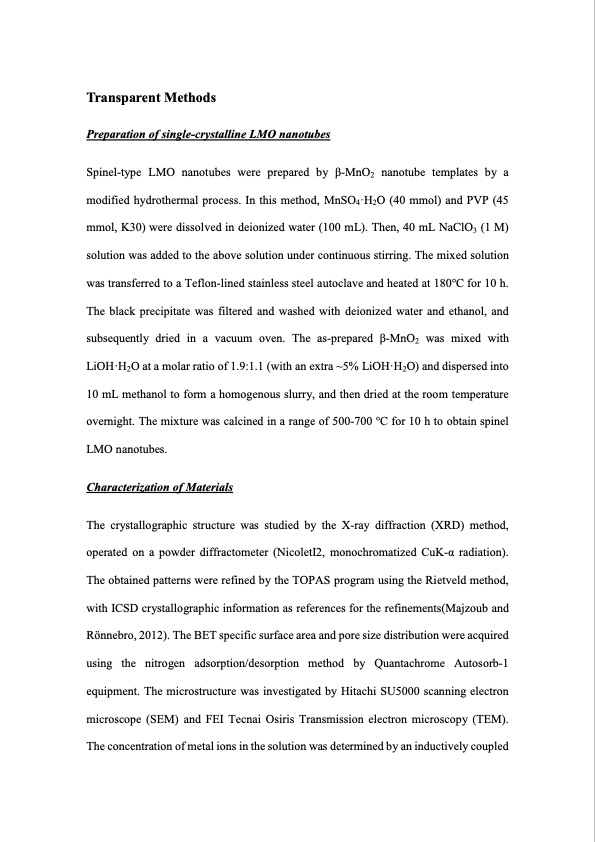
PDF Publication Title:
Text from PDF Page: 012
Transparent Methods Preparation of single-crystalline LMO nanotubes Spinel-type LMO nanotubes were prepared by β-MnO2 nanotube templates by a modified hydrothermal process. In this method, MnSO4·H2O (40 mmol) and PVP (45 mmol, K30) were dissolved in deionized water (100 mL). Then, 40 mL NaClO3 (1 M) solution was added to the above solution under continuous stirring. The mixed solution was transferred to a Teflon-lined stainless steel autoclave and heated at 180°C for 10 h. The black precipitate was filtered and washed with deionized water and ethanol, and subsequently dried in a vacuum oven. The as-prepared β-MnO2 was mixed with LiOH·H2O at a molar ratio of 1.9:1.1 (with an extra ~5% LiOH·H2O) and dispersed into 10 mL methanol to form a homogenous slurry, and then dried at the room temperature overnight. The mixture was calcined in a range of 500-700 °C for 10 h to obtain spinel LMO nanotubes. Characterization of Materials The crystallographic structure was studied by the X-ray diffraction (XRD) method, operated on a powder diffractometer (NicoletI2, monochromatized CuK-α radiation). The obtained patterns were refined by the TOPAS program using the Rietveld method, with ICSD crystallographic information as references for the refinements(Majzoub and Rönnebro, 2012). The BET specific surface area and pore size distribution were acquired using the nitrogen adsorption/desorption method by Quantachrome Autosorb-1 equipment. The microstructure was investigated by Hitachi SU5000 scanning electron microscope (SEM) and FEI Tecnai Osiris Transmission electron microscopy (TEM). The concentration of metal ions in the solution was determined by an inductively coupledPDF Image | Extraction of Lithium from Single-Crystalline Lithium

PDF Search Title:
Extraction of Lithium from Single-Crystalline LithiumOriginal File Name Searched:
PIIS2589004220309652.pdfDIY PDF Search: Google It | Yahoo | Bing
Product and Development Focus for Infinity Turbine
ORC Waste Heat Turbine and ORC System Build Plans: All turbine plans are $10,000 each. This allows you to build a system and then consider licensing for production after you have completed and tested a unit.Redox Flow Battery Technology: With the advent of the new USA tax credits for producing and selling batteries ($35/kW) we are focussing on a simple flow battery using shipping containers as the modular electrolyte storage units with tax credits up to $140,000 per system. Our main focus is on the salt battery. This battery can be used for both thermal and electrical storage applications. We call it the Cogeneration Battery or Cogen Battery. One project is converting salt (brine) based water conditioners to simultaneously produce power. In addition, there are many opportunities to extract Lithium from brine (salt lakes, groundwater, and producer water).Salt water or brine are huge sources for lithium. Most of the worlds lithium is acquired from a brine source. It's even in seawater in a low concentration. Brine is also a byproduct of huge powerplants, which can now use that as an electrolyte and a huge flow battery (which allows storage at the source).We welcome any business and equipment inquiries, as well as licensing our turbines for manufacturing.| CONTACT TEL: 608-238-6001 Email: greg@infinityturbine.com | RSS | AMP |